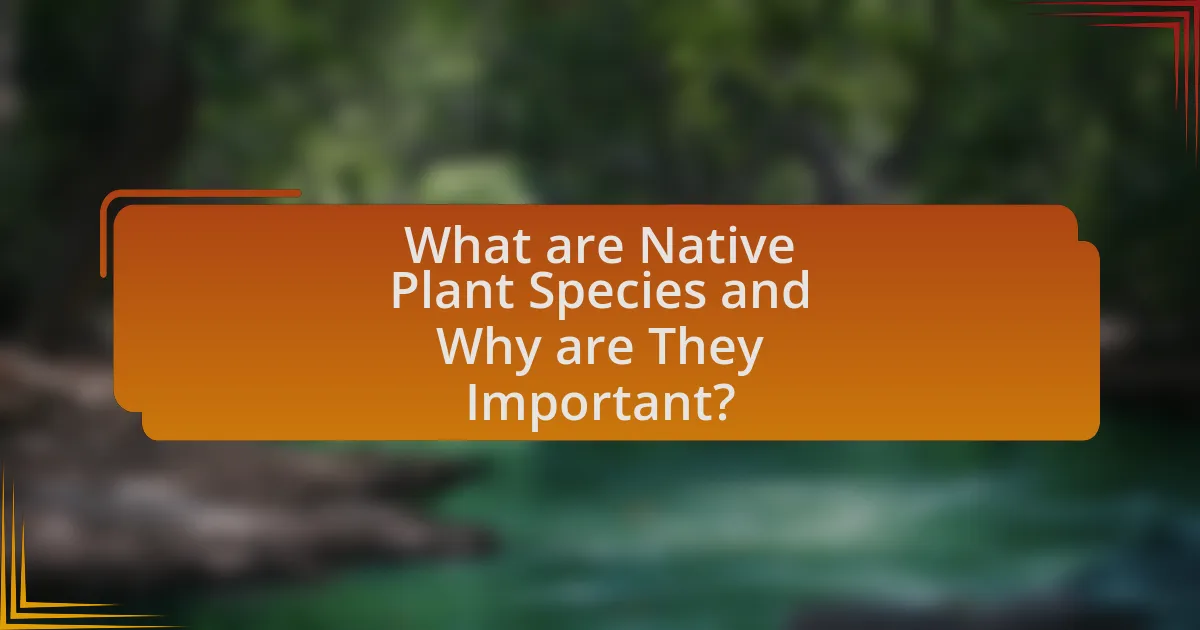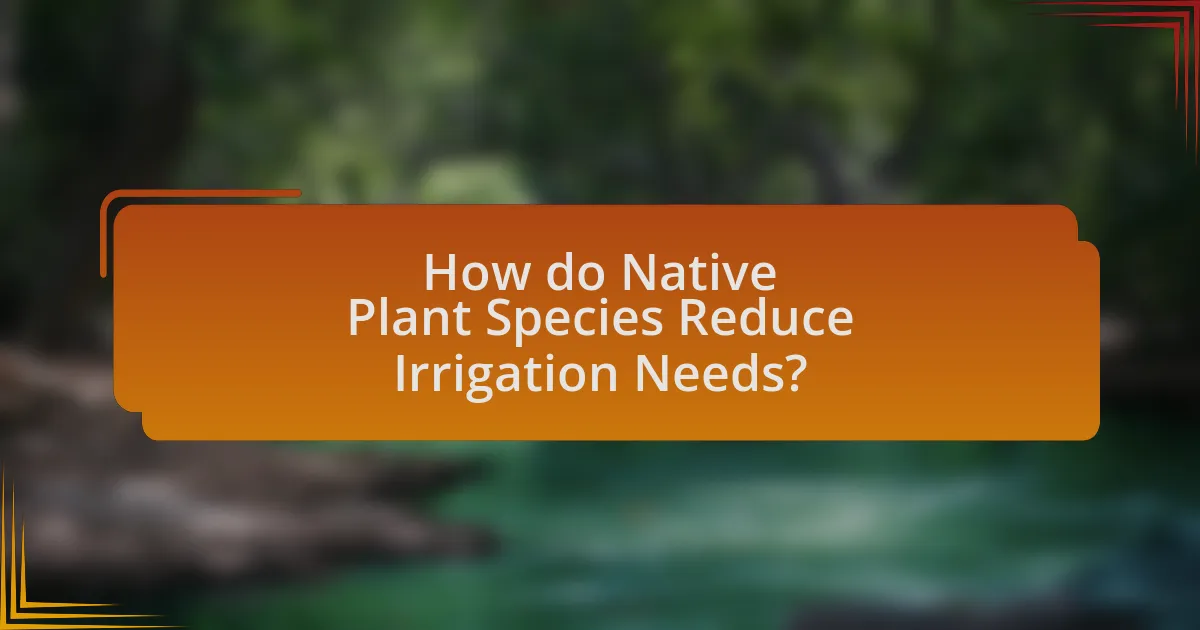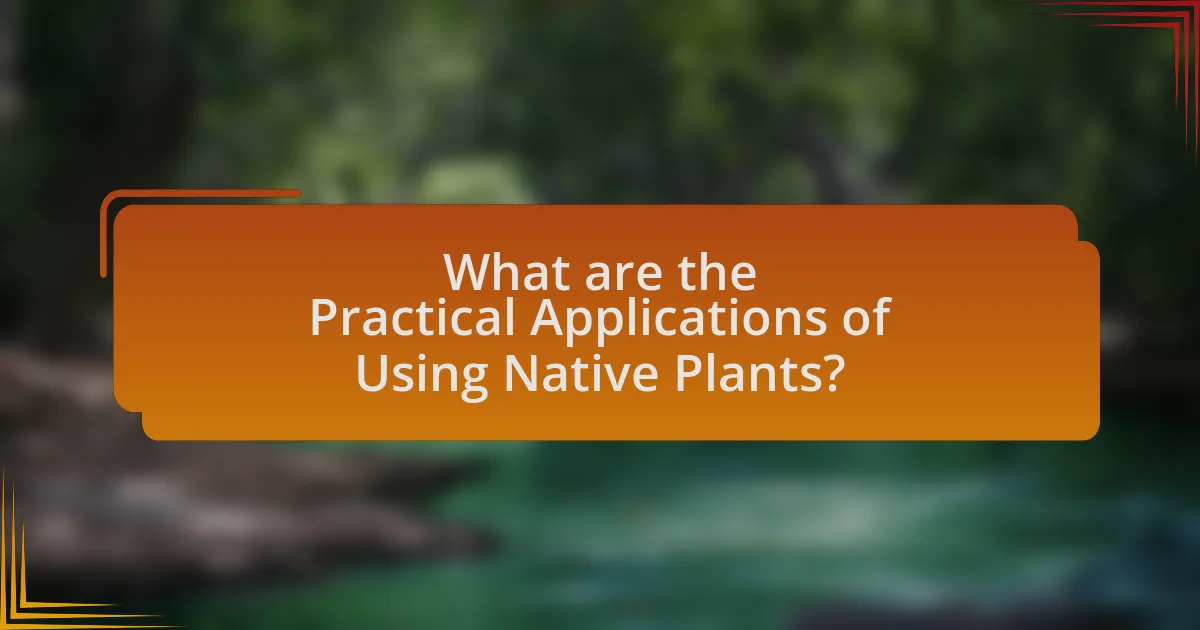Native plant species are plants that naturally occur in specific regions without human introduction, and they play a crucial role in enhancing ecosystem stability and biodiversity. This article explores the importance of native plants in reducing irrigation needs, highlighting their adaptations to local climates and soils that allow them to thrive with minimal water. It discusses the differences between native and non-native species, the ecological benefits of native plants, and practical applications for homeowners and public landscaping projects. Additionally, the article addresses challenges in using native plants and offers resources for promoting their use, emphasizing their significance in sustainable land management practices.
What are Native Plant Species and Why are They Important?

Native plant species are plants that naturally occur in a specific region without human introduction. They are important because they are adapted to local climate, soil, and wildlife, which enhances ecosystem stability and biodiversity. Native plants require less water and maintenance compared to non-native species, making them crucial for reducing irrigation needs. Studies show that landscapes dominated by native plants can reduce water usage by up to 50%, as they are better suited to survive in local conditions. This adaptability not only conserves water but also supports local wildlife, including pollinators and other beneficial organisms, thereby promoting a healthier ecosystem.
How do native plant species differ from non-native species?
Native plant species are those that have evolved in a specific region and are adapted to its local climate, soil, and ecosystem, while non-native species are introduced from other regions and may not be suited to the local environment. Native plants typically require less water and maintenance, as they are adapted to local rainfall patterns and soil conditions, which contributes to reduced irrigation needs. In contrast, non-native species often require additional resources, such as irrigation and fertilizers, to thrive in unfamiliar environments, leading to increased water usage and potential ecological disruption.
What characteristics define native plant species?
Native plant species are defined by their adaptation to the local environment, which includes climate, soil, and other ecological factors. These plants have evolved over time to thrive in specific regions, making them resilient to local pests and diseases. Additionally, native plants typically require less water and maintenance compared to non-native species, as they are well-suited to the local climate and soil conditions. This adaptability contributes to their role in reducing irrigation needs, as they can survive on natural rainfall and require minimal human intervention for growth.
Why are native plants better suited for local environments?
Native plants are better suited for local environments because they have evolved to thrive in specific climatic and soil conditions of their native regions. This adaptation allows them to require less water, making them more efficient in terms of irrigation needs compared to non-native species. Research indicates that native plants can reduce irrigation requirements by up to 50% due to their deep root systems and drought-resistant traits, which enable them to access moisture more effectively. Additionally, native plants support local wildlife and ecosystems, further enhancing their suitability for local environments.
What role do native plants play in ecosystems?
Native plants play a crucial role in ecosystems by supporting biodiversity, enhancing soil health, and improving water retention. These plants provide habitat and food for various wildlife species, which contributes to a balanced ecosystem. Research indicates that native plants are better adapted to local climate and soil conditions, requiring less water and maintenance compared to non-native species. For example, a study published in the journal “Ecological Applications” by Tallamy et al. (2010) found that landscapes dominated by native plants support 3 to 4 times more wildlife than those with non-native plants. This adaptability not only reduces irrigation needs but also promotes resilience against pests and diseases, further stabilizing the ecosystem.
How do native plants support local wildlife?
Native plants support local wildlife by providing essential food sources and habitats that are specifically adapted to the local ecosystem. These plants produce nectar, seeds, and fruits that attract various pollinators, birds, and other wildlife, fostering biodiversity. For instance, studies show that native flowering plants can support up to 50% more pollinator species compared to non-native plants, enhancing the overall health of the ecosystem. Additionally, native plants offer shelter and nesting sites for birds and small mammals, contributing to the stability of local wildlife populations.
What ecosystem services do native plants provide?
Native plants provide essential ecosystem services such as soil stabilization, water regulation, and habitat provision for wildlife. These services contribute to maintaining ecological balance and enhancing biodiversity. For instance, native plants improve soil health by preventing erosion through their root systems, which helps retain moisture and nutrients. Additionally, they play a crucial role in the water cycle by facilitating groundwater recharge and reducing runoff, thereby minimizing the need for irrigation. Research indicates that landscapes dominated by native vegetation require significantly less water compared to those with non-native species, highlighting their importance in sustainable land management practices.
How do Native Plant Species Reduce Irrigation Needs?

Native plant species reduce irrigation needs by being well-adapted to local climates and soil conditions, which allows them to thrive with minimal water. These plants typically possess deep root systems that access moisture from deeper soil layers, reducing reliance on surface irrigation. Additionally, native plants often have physiological traits, such as drought resistance and reduced transpiration rates, that enable them to conserve water effectively. Studies have shown that landscapes featuring native plants can reduce irrigation requirements by up to 50% compared to non-native species, demonstrating their efficiency in water use.
What mechanisms allow native plants to thrive with less water?
Native plants thrive with less water due to several adaptive mechanisms, including deep root systems, water-efficient photosynthesis, and specialized leaf structures. Deep root systems allow native plants to access moisture from deeper soil layers, which is crucial during dry periods. Water-efficient photosynthesis, such as CAM (Crassulacean Acid Metabolism), enables these plants to minimize water loss by opening their stomata at night instead of during the day. Additionally, specialized leaf structures, such as waxy coatings or reduced leaf surface area, help reduce transpiration and conserve water. These adaptations collectively enhance the resilience of native plants in arid environments, supporting their survival with minimal water resources.
How do root systems of native plants contribute to water conservation?
Root systems of native plants contribute to water conservation by enhancing soil structure and increasing water infiltration. These plants typically possess deep and extensive root systems that allow them to access moisture from deeper soil layers, reducing the need for supplemental irrigation. Research indicates that native plants can improve soil porosity and reduce runoff, which leads to better water retention in the landscape. For example, studies have shown that native grasses can increase soil organic matter, which enhances the soil’s ability to hold water, thereby promoting sustainable water use in ecosystems.
What adaptations do native plants have for drought resistance?
Native plants exhibit several adaptations for drought resistance, including deep root systems, reduced leaf surface area, and water-storing tissues. Deep root systems allow these plants to access moisture from deeper soil layers, which is crucial during dry periods. Reduced leaf surface area minimizes water loss through transpiration, while specialized water-storing tissues enable the plants to retain moisture for extended periods. These adaptations are essential for survival in arid environments, where water availability is limited.
Why is reducing irrigation important for sustainability?
Reducing irrigation is important for sustainability because it conserves water resources, which are increasingly scarce due to climate change and population growth. Sustainable water management practices, including reduced irrigation, help maintain the ecological balance by preserving natural water cycles and protecting aquatic ecosystems. For instance, studies show that over 70% of freshwater withdrawals are used for agriculture, highlighting the significant impact of irrigation on water availability. By implementing native plant species that require less water, agricultural practices can become more sustainable, reducing the overall demand for irrigation and promoting biodiversity.
How does excessive irrigation impact local water resources?
Excessive irrigation depletes local water resources by increasing water consumption beyond sustainable levels. This overuse can lead to reduced groundwater levels, diminished surface water availability, and altered hydrological cycles. For instance, studies have shown that in regions with intensive agricultural practices, groundwater depletion can exceed recharge rates by significant margins, resulting in long-term water scarcity. Additionally, excessive irrigation can contribute to soil salinization, further degrading water quality and reducing the availability of clean water for both agricultural and human use.
What are the environmental benefits of reducing irrigation needs?
Reducing irrigation needs offers significant environmental benefits, including the conservation of water resources and the enhancement of soil health. By minimizing water usage, ecosystems can maintain their natural hydrology, which supports biodiversity and reduces the risk of habitat degradation. Furthermore, less irrigation leads to decreased runoff and erosion, promoting healthier soil structure and nutrient retention. Studies indicate that native plant species, which are adapted to local climates and soil conditions, require less water and contribute to these benefits by improving water infiltration and reducing evaporation rates. This results in a more sustainable ecosystem that can better withstand climate variability and support local wildlife.
What are the Practical Applications of Using Native Plants?

The practical applications of using native plants include enhancing biodiversity, reducing irrigation needs, and improving soil health. Native plants are adapted to local climates and soils, which allows them to thrive with minimal water, thus significantly lowering irrigation requirements. For example, studies have shown that landscapes featuring native plants can reduce water usage by up to 50% compared to non-native landscapes. Additionally, native plants support local wildlife, including pollinators, which contributes to ecosystem stability and resilience. Their deep root systems also improve soil structure and prevent erosion, further promoting environmental health.
How can homeowners incorporate native plants into their landscapes?
Homeowners can incorporate native plants into their landscapes by selecting species that are well-adapted to the local climate and soil conditions. This approach not only enhances biodiversity but also significantly reduces irrigation needs, as native plants typically require less water once established. Research indicates that landscapes featuring native plants can reduce water usage by up to 50% compared to traditional landscaping, as these plants are adapted to local rainfall patterns and soil types. By creating a landscape design that prioritizes native flora, homeowners can contribute to environmental sustainability while enjoying a low-maintenance garden.
What are the best native plants for different climates?
The best native plants for different climates include species that are adapted to their specific environmental conditions, which helps reduce irrigation needs. For arid climates, plants like Agave and Yucca are ideal due to their drought resistance. In temperate regions, native grasses such as Little Bluestem and Wild Bergamot thrive, requiring less water once established. For tropical climates, species like Hibiscus and Plumeria are effective, as they are well-suited to high humidity and rainfall. These plants not only conserve water but also support local ecosystems by providing habitat and food for wildlife.
How can native plants be used in public landscaping projects?
Native plants can be used in public landscaping projects to create sustainable and low-maintenance green spaces that require minimal irrigation. By selecting species that are adapted to the local climate and soil conditions, municipalities can significantly reduce water usage, as native plants are more resilient to drought and local pests. Research indicates that landscapes featuring native plants can reduce irrigation needs by up to 50% compared to non-native species, as they are better suited to thrive in their natural environment. This approach not only conserves water but also supports local biodiversity and enhances the ecological health of the area.
What are some common challenges in using native plants?
Common challenges in using native plants include limited availability, potential for invasive species, and varying growth conditions. Limited availability can hinder landscape projects, as not all native species are readily accessible in nurseries. Additionally, some native plants may become invasive in certain environments, outcompeting local flora and disrupting ecosystems. Furthermore, varying growth conditions, such as soil type and moisture levels, can affect the establishment and success of native plants, making it essential to match species to specific site conditions for optimal performance.
How can gardeners overcome misconceptions about native plants?
Gardeners can overcome misconceptions about native plants by educating themselves and their communities about the ecological benefits and adaptability of these species. Research indicates that native plants require less water and maintenance compared to non-native species, making them ideal for sustainable gardening practices. For instance, a study by the Lady Bird Johnson Wildflower Center found that native plants can reduce irrigation needs by up to 50% once established. By sharing this information through workshops, community gardens, and social media, gardeners can dispel myths and promote the advantages of incorporating native plants into their landscapes.
What resources are available for selecting and maintaining native plants?
Resources for selecting and maintaining native plants include local extension services, native plant societies, and online databases. Local extension services provide region-specific guidance on plant selection and care, often offering workshops and publications. Native plant societies, such as the North American Native Plant Society, offer resources, plant lists, and expert advice tailored to specific areas. Online databases like the USDA PLANTS Database and the Lady Bird Johnson Wildflower Center provide comprehensive information on native species, including their ecological benefits and maintenance requirements. These resources collectively support informed decisions in selecting and maintaining native plants, which are crucial for reducing irrigation needs.
What are the best practices for promoting native plant use?
The best practices for promoting native plant use include educating the public about their ecological benefits, providing resources for sourcing native plants, and encouraging local landscaping initiatives that prioritize native species. Education can be facilitated through workshops, informational brochures, and community events that highlight how native plants support local wildlife and reduce irrigation needs. Resources such as native plant nurseries and online databases can help individuals and landscapers find appropriate species for their regions. Additionally, local governments and organizations can promote landscaping initiatives that incentivize the use of native plants, thereby fostering community engagement and environmental stewardship. These practices are supported by studies showing that native plants require less water and maintenance compared to non-native species, making them a sustainable choice for landscaping.
How can community initiatives support the use of native plants?
Community initiatives can support the use of native plants by organizing educational programs that raise awareness about their ecological benefits and water conservation properties. These initiatives can facilitate workshops and community gardens that specifically focus on planting and maintaining native species, which are adapted to local climates and require less irrigation. Research indicates that native plants can reduce water usage by up to 50% compared to non-native species, making them a sustainable choice for landscaping. By promoting native plants through community engagement, these initiatives not only enhance biodiversity but also contribute to more efficient water management practices.
What educational resources are available for promoting native plant awareness?
Educational resources available for promoting native plant awareness include online databases, educational websites, and community workshops. For instance, the Lady Bird Johnson Wildflower Center provides extensive information on native plants through its website, which features plant databases, gardening tips, and educational articles. Additionally, organizations like the National Wildlife Federation offer resources such as guides and webinars focused on the benefits of native plants. Community workshops and local gardening clubs often host events to educate the public about native species and their role in sustainable landscaping, which can significantly reduce irrigation needs.


